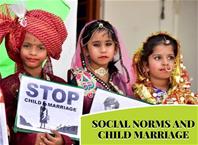
Our Blogs

SOCIAL NORMS AND CHILD MARRIAGE
I have always asked myself, as well as some of the girls who are returning to school - "If marriage is a matter of choice?"
COVID-19, is just a new addition, among a variety of other existing, circulating unchecked and unopposed, anti-civilization agents since time immemorial, which threatens and feeds upon the centuries-old strong social fabric among humans. All this started exactly a month back when the whole world was celebrating International Women's Day. I had a brief conversation with a lovely teenage girl while interacting with the dropout girls at Pratham Ngo. She told me how certain mundane customs and beliefs prevailing in her village, compelled her and her family to stop her school education. This propelled and opened an entirely new dimension and thought process in my mind, regarding the extent of the role of social norms in the prevailing incidences of existing social evils in our society against the girl child, like Child Marriage. This write-up is an outcome of this deep analysis and brainstorming, on the topic of "Role of social norms in Child Marriage", during my present self-quarantine period, due to the ongoing 21days lockdown period in India.
Child marriage is referred to as a “culture”, a “practice”, an “institution”, a “custom”, a “convention”, a “social norm”, or a “moral” imperative...
The collective practices of child marriage can be sustained by two kinds of preferences, namely unconditional and conditional, and two kinds of beliefs, namely nonsocial and social. Measuring both these preferences and both these beliefs, allows us to determine whether a collective practice is a social norm or not.
Social Beliefs/ Expectations | Non- Social beliefs | |
Non-Normative Beliefs | Empirical Expectation | Factual Belief |
Normative Beliefs | Normative Expectations | Personal Belief |
Table:-1 Classification of beliefs according to social and non-social.
This collective practice of child marriage is, ultimately, a cluster of individual behaviours, so that, if we want to understand it, we have to understand why individuals behave in certain ways. One important aspect of people’s behaviour is that it is often influenced by what other people do and by what other people think should be done.
Definition | Example | |
Factual Belief | Belief about reality other than about people’s behaviour and thought. | An older girl will not find a good husband. |
Personal Belief | Belief about what one should do | I should marry my daughter as soon as she reaches puberty |
Empirical Expectations | Belief about what people do | All my neighbours marry their daughter as soon as they reach puberty. |
Normative Expectations | Belief about what other people think one should do. | My neighbours think that one should marry ones daughter as soon as she reaches puberty. |
Table:-2 Different types of Belief with examples and how they impact child marriage.
SOCIAL NORM
A social norm is a rule of behavior, such that individuals prefer to conform to it, on condition they believe that, most people in their relevant network conform to it (empirical expectations), and they ought to conform to it(normative expectations).
Not everybody’s preferences are conditional on their social expectations, nor they are equally sensitive to social expectations. Sensitivity to social expectations is often due to a lack of agency or autonomy. Autonomy is the ability and desire to make one’s own choices, to choose what one really wants, and to reflect on what one might want, rather than having others make choices for you and decide for you what you want. In short, autonomy is self-determination or personal freedom. Not all people are equally autonomous. Hence, many child marriage programs aim at empowering women at increasing their level of autonomy so that they can abandon harmful social norms and perhaps even take the lead in the collective process of change.
The importance of social expectations to the existence of norms indicates that behaviours, as well as beliefs, are interrelated. To understand certain parents’ decision to marry off their daughter early, you have to know what other parents are doing and thinking. Now, parents are not the only actors that sustain child marriage. In fact, child marriage is sustained by many behaviours performed by many actors, as is illustrated in the diagram below. Monitoring progress in ending child marriage thus requires monitoring the preferences, options, and beliefs of all these different actors.

Child marriage is a serious human rights crisis and one of the most pressing development concerns in the world today. A committed inclusive approach will contribute significantly to not only creating a world where girls are free to decide if, when, and whom to marry, but also one where girls and women are safer, healthier, valued and empowered.
References:-
1 -Paper on "Social norms perspective on child marriage " (Commissioned by UNICEF).
Written By - Bhagyashree Saini (Social Activist)
Share This Article
0 Comments
In a compartmentalized world, the rights of women and those of children have often been promoted in isolation from one another.
"I CAN" shows how discrimination and other human rights violations against women affect children and vice versa.
About Us
Our Work
Contact Us
Address:56 - C, First Floor, Opposite Hotel Hilton, Hawa Sadak,
Civil Lines, Jaipur, Rajasthan 302006Phone: +91 730 000 1413
Email: connect@icanfoundationindia.org
Our Causes
We are effectively working for major development issues: promoting the human rights of adolescent girls, eliminating child marriage, Gender equality, the protection of human rights, especially of children, survival, protection, development and participation of every child and women of India.
Read more
Quick Links
Help Building in Better World
Your donation helps to improve the lives of people in and from foster care.
Donate Now







